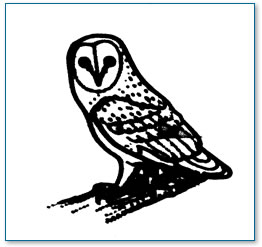birds
A very good indication
of the water quality in streams can be to look at the bird-life
present in the area close by. Birds do not live in the water but
eat the fish and other creatures that live in it when the water
quality is good.
For example, some birds like
the Kingfisher and the Dipper eat invertebrates and small fish.
If the water quality of a stream is poor then the chances of it
supporting invertebrate and fish-life will be reduced.
 |
Dipper |
You might be lucky enough to
spot a flash of brilliant blue as a Kingfisher flies along a stream
whilst you are visiting the area as part of a fieldtrip. Kingfishers,
as their name suggests, eat fish. As they dive into a river or stream
their long dagger-like beak is used to spear their prey.
Kingfishers also feed on the invertebrates (B09a)
found in streams with good water quality. If there are no invertebrates
and in turn no fish it is unlikely that any Kingfishers will live
there for you to see.
Fish (B09d)
also rely on the presence of certain invertebrates which form an
important part of their diet. Already you can see a food chain developing
(see Food Web section B06d)
and the importance of good water quality to support this chain will
be becoming clearer.
The Dipper is a less colourful
bird in appearance, but not in habit. This small brown and white
bird is an adept forager of streams, looking for invertebrates and
fish. Unlike the Kingfisher, who flies and then dives, the Dipper
will often stand on a rock in the middle of a stream and bob.
This bird can swim both on and
below the waters’ surface, it has the ability to run along
the stream bed underwater, being held down by the current. This
enables the bird to winkle out caddis fly and mayfly nymphs (B09a)
and sometimes small fish like bullheads. Dippers build nests made
from moss and plants, sometimes making use of a hole in the riverbank
or under a bridge or weir.
To find out more about Dippers click here
 |
Cliff with sandmartin holes
|
Some of the birds that indicate
good water quality do not live near streams and rivers in Britain
all the time. Birds like the Sand Martin are summer visitors, so
if you visit a stream in the Spring, Autumn or Winter you would
not expect to see them. Sand Martins migrate to warmer parts of
the world and will return again in the Summer. These birds feed
on flying insects found near rivers - moths and midges for example.
Sand Martins live in colonies
in holes in riverbanks, you might be able to see these holes even
if you miss seeing the bird. Because these birds migrate, the amount
that arrive in this country could be affected by drought or shooting
on their journey. Unsuitable conditions when they reach Britain
including pollution will also affect their survival.
 |
Heron |
Of course their are other birds
that you might be lucky enough to spot when you are beside a stream,
river, pond or lake. For example ducks and herons are just two kinds
of birds that rely on water for their food and so might be seen
on a field trip.
 |
Cormorant |
Swallows and martins swoop down over the water catching midges.
Nearer the coast, Cormorants – large goose-like birds –
prey on fish in rivers and estuaries.
 |
Woodpecker |
If there are trees beside the river you might hear a woodpecker
tap-tapping away at an old trunk, or at dusk an owl might swoop
down through the trees hunting for voles in the rough grass.
 |
Barn Owl |
To look at more birds that you are likely
to see on, near or maybe even under water in Cornwall go to the
RSPB website - click here
to visit the RSPB website
|

